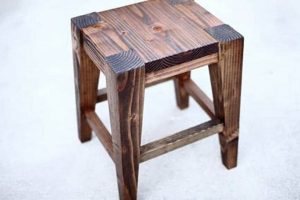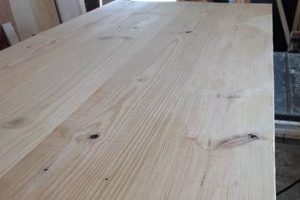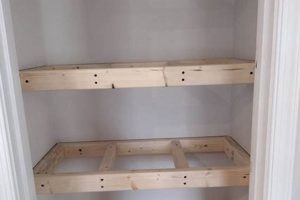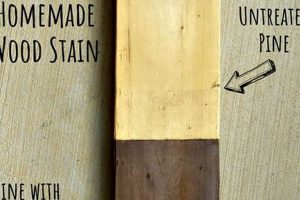The construction of a self-made container for implements using timber represents a practical project for organizing and protecting various tools. Such a container typically incorporates features like compartments or trays to facilitate the segregation of different tool types, and may include a handle for ease of portability. Various woodworking techniques are employed during fabrication. As an example, a carpenter might construct a rectangular box with a hinged lid and internal divisions to store chisels, screwdrivers, and measuring devices.
A project of this nature provides benefits such as customized storage solutions tailored to specific tool collections and workspace dimensions. Furthermore, construction with timber offers a cost-effective and durable alternative to commercially manufactured options. Historically, crafting a tool container from available lumber was a common practice, reflecting resourcefulness and self-sufficiency in tool management. This approach continues to be relevant for those seeking to optimize their organizational systems.
Subsequent sections will detail material selection considerations, the design process, woodworking methods applicable for crafting robust and functional containers, and offer guidance on surface finishing to enhance durability and aesthetic appeal. Different construction techniques suitable for various skill levels will be explored.
Essential Considerations for Timber Tool Container Construction
The following recommendations are intended to provide guidance when embarking on the creation of a wooden repository for implements, ensuring structural integrity and long-term utility.
Tip 1: Material Selection: The choice of timber is paramount. Hardwoods such as oak or maple offer superior durability and resistance to wear compared to softwoods like pine. Proper consideration of wood grain orientation enhances the overall strength of the completed structure.
Tip 2: Accurate Measurements: Precise measurements are crucial for a well-fitting assembly. Use accurate measuring tools and double-check all dimensions before cutting. Discrepancies in size can compromise structural integrity and necessitate rework.
Tip 3: Joint Selection: The selected joint types dictate the overall strength and appearance of the container. Dovetail joints are robust and aesthetically pleasing, while simpler butt joints secured with screws or nails are suitable for less demanding applications. Mitre joints provide a clean aesthetic for box corners.
Tip 4: Proper Fasteners: Appropriate fasteners are essential for securely holding components together. Wood screws with countersunk heads provide a secure and flush fit. Avoid over-tightening screws, as this can lead to wood splitting.
Tip 5: Lid Construction: Careful consideration should be given to the construction of the lid. A hinged lid requires precise alignment and sturdy hinges. A sliding or removable lid must fit snugly to prevent tools from falling out, while allowing easy access.
Tip 6: Surface Treatment: Application of a protective finish extends the lifespan of the wooden construction. Varnishes, lacquers, or oil-based finishes protect against moisture and abrasion. Proper surface preparation, including sanding and cleaning, ensures optimal adhesion of the finish.
Tip 7: Internal Organization: Plan the internal layout to accommodate specific tool requirements. Custom dividers and trays facilitate organization and prevent tools from damaging each other. Secure placement of tools prevents movement during transport.
Careful adherence to these guidelines promotes the creation of a durable, functional, and aesthetically pleasing solution for tool storage and organization. The result is a container well-suited to withstand regular use and protect its contents.
Subsequent sections will explore advanced woodworking techniques and provide detailed plans for various tool container designs.
1. Wood Selection
The selection of timber directly impacts the longevity, structural integrity, and overall utility of a self-constructed tool container. Different wood species exhibit varying degrees of hardness, density, and resistance to moisture and insect infestation, properties that directly influence a tool box’s capacity to withstand daily use and environmental exposure. A poorly chosen wood can lead to premature failure, rendering the entire project impractical.
For instance, using softwood like pine for a heavily loaded tool box may result in bowing or cracking under the weight of the contained tools. Conversely, hardwoods such as oak or maple, while more expensive, provide superior strength and resistance to abrasion, extending the tool box’s lifespan significantly. Similarly, moisture-resistant woods like cedar can be preferable in environments prone to humidity, preventing rot and warping. Therefore, proper material selection is not merely an aesthetic consideration but a functional imperative for a successful self-made tool container. Careful evaluation of wood properties relative to anticipated use is crucial.
In summary, wood selection constitutes a foundational element of tool container construction. Neglecting material properties can undermine the entire project, leading to early degradation and functional inadequacy. Understanding the relationship between wood characteristics and tool box performance is paramount for achieving a durable and reliable storage solution. The initial investment in appropriate materials often translates into long-term cost savings by mitigating the need for frequent repairs or replacements.
2. Joint Strength
In the context of self-constructed timber receptacles for implements, joint strength is a determining factor in overall structural integrity and longevity. The method by which individual wood components are connected directly impacts the ability of the entire structure to withstand loads, impacts, and the stresses of regular use. Weak joints compromise the functionality of the tool box, potentially leading to premature failure and damage to the tools contained within. For example, if simple butt joints are used without reinforcement in a large tool box intended to hold heavy metal tools, the joints may separate under the weight, rendering the structure unusable. Conversely, robust joinery techniques like dovetails or mortise-and-tenon joints provide significantly greater resistance to tensile and shear forces.
Consider a scenario where a tool box constructed with adequately strong joints is accidentally dropped. The inherent strength of the joints will distribute the impact force across the entire structure, minimizing the risk of catastrophic failure. By contrast, a box with weaker joints will likely disassemble upon impact, scattering the contents and potentially causing damage. The choice of joint depends on the intended use of the tool box, the weight of the tools to be stored, and the skill level of the builder. Simpler joints, such as rabbet joints, can be reinforced with screws or glue to enhance their strength for lighter-duty applications.
In summation, joint strength represents a critical engineering element in the creation of durable and functional self-made timber tool repositories. Proper consideration of joint selection, coupled with meticulous execution, contributes significantly to the overall reliability and lifespan of the tool box. The investment in time and effort to master robust joinery techniques is a worthwhile endeavor, resulting in a container capable of withstanding the rigors of practical use and protecting its valuable contents.
3. Internal Dividers
Within the domain of self-constructed implement repositories utilizing timber, internal dividers represent a critical design element dictating organizational efficiency and tool protection. Their integration transcends mere aesthetic consideration, directly influencing the accessibility, security, and overall functional utility of the container.
- Compartmentalization for Organization
Internal dividers facilitate the segregation of tools by type, size, or frequency of use. This compartmentalization prevents tool clutter, allowing for rapid identification and retrieval. As an example, a series of vertical dividers can be implemented to create individual slots for chisels, while smaller, shallower compartments might house measuring devices or small fasteners. The implementation of this system reduces search time and enhances workflow efficiency.
- Protection Against Damage
Effective implementation of internal dividers mitigates the risk of tools colliding with one another during transport or storage. Such collisions can result in damage to delicate edges, calibration errors in measuring tools, or accelerated wear. By creating physical separation, dividers minimize the potential for tool-on-tool contact, thereby preserving the integrity of individual implements. This is particularly important for tools with precision-ground surfaces or sensitive components.
- Customization for Specific Tool Sets
The bespoke nature of self-constructed timber tool containers allows for internal dividers to be tailored precisely to the specific tool collection of the user. This contrasts with commercially available options, which often provide generic layouts that may not optimally accommodate all tools. By designing custom dividers, the user can ensure a snug and secure fit for each item, maximizing space utilization and minimizing wasted volume. This level of customization is a significant advantage of the DIY approach.
- Material and Construction Considerations
The selection of materials for internal dividers should align with the overall construction of the tool container. Thin plywood or solid wood are common choices, offering a balance of strength and ease of fabrication. The method of attachment, whether through gluing, screwing, or interlocking joinery, should ensure that the dividers remain securely in place, even under the weight of the tools. Consideration must also be given to the potential for the dividers to expand or contract with changes in humidity, preventing binding or loosening over time.
In conclusion, internal dividers are integral to the design and functionality of self-made timber tool repositories. Their strategic implementation promotes organization, protects tools from damage, and allows for customization tailored to individual tool collections. The design and construction of these dividers should be carefully considered to ensure long-term utility and optimal performance within the overall tool container system. This level of control is crucial for a functional and long lasting tool box.
4. Protective Finish
The longevity and resilience of self-constructed wooden tool repositories are critically contingent upon the application of a suitable protective finish. Timber, being a hygroscopic material, is susceptible to environmental factors such as moisture, temperature fluctuations, and ultraviolet (UV) radiation. These elements can lead to warping, cracking, fungal growth, and discoloration, compromising the structural integrity and aesthetic appeal of the tool box. A protective finish acts as a barrier, mitigating these detrimental effects. For instance, a varnish coating applied to a wooden tool box shields the underlying wood from water damage, preventing swelling and subsequent joint failure. Similarly, a UV-resistant finish can inhibit fading and degradation caused by sunlight exposure. Without this protective layer, the investment in time and materials involved in crafting the tool box is jeopardized.
The selection of an appropriate protective finish necessitates careful consideration of the intended environment and the type of wood used. Oil-based finishes, such as linseed oil, penetrate the wood grain, providing protection from within while enhancing the natural beauty of the wood. However, they may offer limited resistance to abrasion and require periodic reapplication. In contrast, film-forming finishes like polyurethane create a durable surface layer that is resistant to scratches and impacts. However, they may be less flexible and prone to cracking if the wood expands or contracts significantly. Epoxies offer a high level of chemical resistance and structural reinforcement, but can be more challenging to apply and may alter the appearance of the wood. A practical application involves using a spar varnish on a tool box intended for outdoor use, given its superior resistance to moisture and UV light compared to interior varnishes.
In summary, a protective finish is not merely an aesthetic enhancement but a fundamental component of any self-constructed wooden tool box intended for long-term use. Its function is to safeguard the underlying wood from environmental degradation, thereby extending the lifespan and maintaining the structural integrity of the container. Proper selection and application of the finish, tailored to the specific wood type and environmental conditions, is essential for realizing the full potential of a “diy tool box wood” project. Neglecting this aspect can lead to premature deterioration, rendering the investment of time and resources ineffective. This critical step ensures the value and longevity of the crafted item.
5. Load Capacity
The ability of a self-constructed timber implement repository to withstand the weight of its contents, known as load capacity, is a critical design parameter directly influencing its functionality and lifespan. Insufficient load capacity leads to structural failure, rendering the tool box unusable and potentially damaging the stored tools. The type of wood selected, the joinery techniques employed, and the overall dimensions of the construction are all factors that determine the maximum weight a “diy tool box wood” project can safely bear. A box constructed from thin plywood with simple butt joints, for instance, will exhibit a significantly lower load capacity compared to one built from solid hardwood using dovetail joints.
Exceeding the designed load capacity results in deformation, cracking, or complete collapse of the tool box. This can occur gradually over time due to creep, a phenomenon where wood deforms slowly under sustained load. An example would be a large tool box designed to hold 50 pounds of tools being consistently loaded with 75 pounds; over several months, the bottom may begin to sag, eventually leading to joint separation. Understanding the relationship between material properties, structural design, and anticipated tool weight is, therefore, essential. Calculations and estimations considering the weight of the densest tools and the distribution of that weight within the box are necessary for safe design parameters. Internal supports and reinforcing elements can augment the load-bearing capabilities of the structure.
In conclusion, load capacity is an indispensable design consideration for any timber-based tool storage solution. Accurate assessment of tool weight, coupled with appropriate material selection and construction methods, ensures a robust and reliable container. Overestimation of the required capacity adds unnecessary weight and material cost, while underestimation results in structural failure and potential tool damage. This necessitates a balanced approach, integrating sound engineering principles with practical woodworking skills to achieve optimal functionality and longevity for a “diy tool box wood” project.
Frequently Asked Questions Regarding Wooden Tool Container Construction
The following questions and answers address common inquiries concerning the design, construction, and maintenance of self-made tool storage solutions utilizing timber materials.
Question 1: What wood species are most suitable for tool container construction?
Hardwoods such as oak, maple, and birch are generally preferred due to their high density and resistance to abrasion. Softwoods like pine and fir are less durable but can be utilized for lighter-duty applications with appropriate reinforcement.
Question 2: What are the key considerations when designing the internal layout of a tool container?
The internal layout should be tailored to the specific tool collection being stored, with compartments and dividers sized appropriately to prevent tool movement and damage. Accessibility and ease of retrieval should also be prioritized.
Question 3: How can I ensure the joints in my tool container are strong and durable?
Utilizing robust joinery techniques such as dovetails, mortise-and-tenon joints, or rabbet joints reinforced with screws is crucial. Proper gluing and clamping during assembly also contribute to joint strength.
Question 4: What type of finish should be applied to protect a wooden tool container?
A durable finish such as varnish, polyurethane, or lacquer is recommended to protect the wood from moisture, scratches, and UV damage. The specific choice of finish should be based on the intended environment and level of protection required.
Question 5: How can I prevent my wooden tool container from warping or cracking?
Selecting kiln-dried lumber with a stable moisture content is essential. Applying a protective finish and storing the tool container in a climate-controlled environment can also help minimize warping and cracking.
Question 6: What is the recommended load capacity for a wooden tool container?
The recommended load capacity depends on the size of the container, the type of wood used, and the joinery techniques employed. It is essential to estimate the weight of the tools to be stored and design the container accordingly, with internal supports added if necessary.
These responses provide foundational guidance for individuals undertaking the creation of custom tool storage solutions using timber. Adhering to these principles enhances the functionality and longevity of the finished product.
Subsequent sections will provide detailed construction plans and advanced woodworking techniques applicable to “diy tool box wood” projects.
Conclusion
This exploration has detailed critical facets of constructing a self-made implement repository utilizing timber, “diy tool box wood.” The considerations presented encompass material selection, joinery techniques, load capacity, internal organization, and the imperative application of a protective finish. Mastery of these elements directly impacts the structural integrity, functionality, and overall lifespan of the resulting tool container.
The creation of a robust and functional tool storage solution represents a significant investment in both time and resources. Meticulous planning and execution, coupled with an understanding of fundamental woodworking principles, are paramount. The resulting product offers not only a bespoke storage solution but also the inherent satisfaction derived from skillful craftsmanship. Those embarking on this endeavor are encouraged to prioritize durability and practicality, ensuring a lasting and valuable addition to their workshop.







